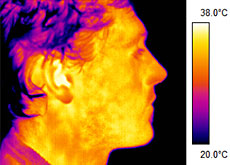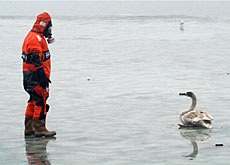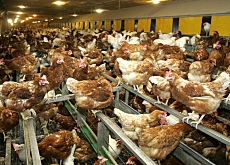Airline passengers may be screened for fever

The Swiss authorities are examining the use of fever-detecting cameras at airports to help protect the country in the event of a human bird flu pandemic.
The Federal Health Office has commissioned a research study to assess the practicality of using thermal imaging cameras to screen for the deadly disease.
The first part of the study will be finished by May when the materials research institute, Empa, will present its findings to the health office.
“These cameras can read skin and eye temperature,” Empa’s René Rossi told swissinfo. “We just completed a whole series of tests, now we are going to evaluate the results and write the report. Then we’ll decide with the health office how to continue.”
Empa evaluated various cameras before choosing to work with two. The institute’s goal was to find the simplest method possible, so that the cameras would be user-friendly.
“It has to be a very quick screening process and easy to handle so that a large number of people could be monitored effectively,” Rossi said.
Patrick Mathys, epidemiologist at the Federal Health Office, told swissinfo that installing thermal imaging cameras at airports was one measure being considered as part of the strategy to deal with a possible bird flu outbreak in humans.
“These cameras were developed for a totally different purpose so more technical know-how is needed to use them to detect fever in people,” he added.
Sars crisis
Thermal imaging to detect fever was first used on air travellers worldwide during the Sars crisis in 2003 and research in the area is relatively limited.
Sars spread rapidly across the globe, mainly due to air travel, prompting the World Health Organization to request that all affected areas screen departing passengers for Sars symptoms.
One difficulty with thermal imaging is that it only measures surface temperature and skin temperature does not necessarily correspond to core body temperature.
The Empa research should shed more light on the correlation between surface and core temperature, Rossi said.
“We are part of the scientific community and we’re also interested in the outcome of the study ourselves. We want to contribute to the knowledge of the thermal physiology of the human body,” Rossi added.
According to Mathys, the legal framework is already in place to introduce infrared cameras at airports in the event of a threat to public health.
Medical and paramedical personnel would be required to report any person testing positive for fever.
“If it is established that the person is likely ill with the disease we are looking for, the person would be taken to a hospital for further investigations,” Mathys explained.
After the health office receives Empa’s report in May, it will either commission more research or decide when and in what situation it would make sense to have thermal imaging cameras.
“This is only one of a series of tools we will have at our disposal,” Mathys said.
“We will also be able to distribute information and questionnaires on board planes and access data on passengers, to see where they are travelling onto in case they need to be notified of a possible infection.”
Since February 20, poultry farmers have had to keep their animals indoors for an indefinite period as a preventive measure.
From October 25 to December 15 last year – the autumn migration period – Switzerland banned the keeping of domestic poultry outdoors.
Veterinary experts took samples from 800 migratory birds, but found no trace of bird flu.
Switzerland also banned imports of poultry products from affected countries and airport checks have been stepped up.
The anti-flu drug Tamiflu has been stockpiled to treat a quarter of the Swiss population.
The H5N1 virus has devastated poultry stocks and killed at least 92 people, mostly in Asia, since 2003.
Fresh outbreaks have been reported in birds in 14 countries since early February.
So far it remains difficult for humans to catch bird flu, but experts fear the virus could mutate, setting off a flu pandemic.

In compliance with the JTI standards
More: SWI swissinfo.ch certified by the Journalism Trust Initiative




You can find an overview of ongoing debates with our journalists here . Please join us!
If you want to start a conversation about a topic raised in this article or want to report factual errors, email us at english@swissinfo.ch.